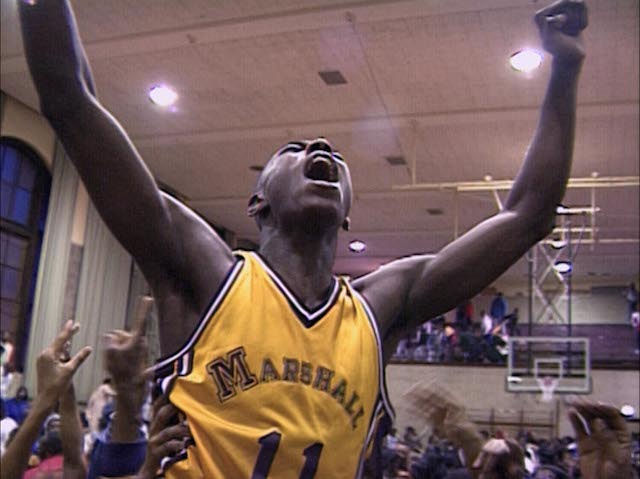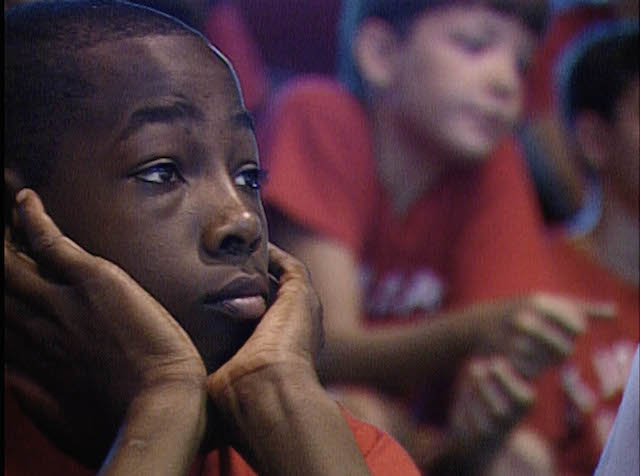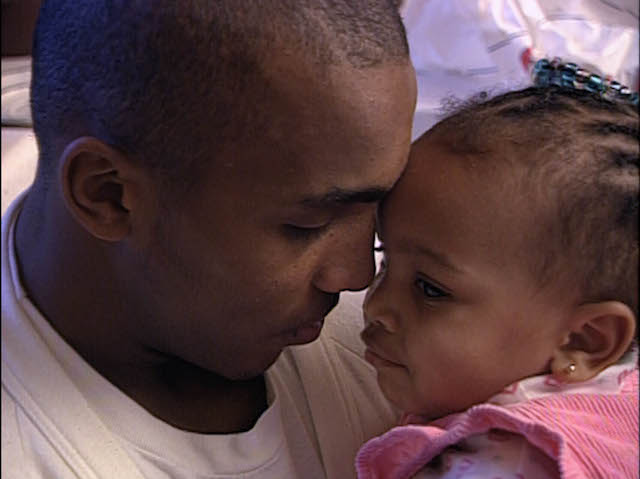'Hoop Dreams' Still Rings True In Chicago, More Than 20 Years Later
By Chicagoist_Guest in Arts & Entertainment on Jun 24, 2016 8:48PM

Still courtesy of Kartemquin Films
By Quinten Rosborough
Chicago production house Kartemquin Films is celebrating its 50th anniversary, and its most famous film Hoop Dreams deserves a second look. The critically-acclaimed documentary chronicled the high school basketball careers of two black Chicago teenagers with dreams of making it to the NBA, but the film is much more than a portrait of early basketball stardom. It's about black families in Chicago's underserved neighborhoods, where little has changed.
If you haven’t seen Hoop Dreams—which I hadn’t, either, until recently (but you can find it streaming on Netflix!)—here’s the gist: William Gates and Arthur Agee, two eighth graders from Cabrini-Green and East Garfield Park, respectively, dream of making it to the NBA. They’re recruited to play basketball at St. Joseph High School in Westchester, Illinois, and almost immediately, their paths diverge. William makes St. Joseph’s varsity team as a freshman and is on track to earn a Division I scholarship, while Arthur struggles academically. The film follows the boys and their families over the next five years, tracking how their lives change.
Originally, the documentary was pitched as a half-hour special on PBS about the culture around streetball and basketball in the black community, according to a 2014 oral history. In the finished product, though, basketball serves as an entry point into a much larger discussion around big issues relevant to this day: economic hardship and marginalization on the South and West sides of Chicago and the fraught lives of young men in those neighborhoods transitioninginto adulthood. The lure of making it in the NBA and becoming a rags-to-riches story only raises the stakes.
Basketball Recruiting Has Only Gotten Crazier Since 1994
The general arc of William and Arthur’s story will be familiar for anyone who’s followed Chicago high school basketball over the last couple of years. Many of the city’s best players continue to migrate from the South and West sides to powerhouses in the Chicago suburbs, but in 2016, high school basketball has accelerated far beyond anything Hoop Dreams filmmakers Steve James and Frederick Marx imagined. For one, by the time the current generation of prospects turns 13—the age at which we’re introduced to William and Arthur—they’re already under an international spotlight. As early as the third grade, their potential has been analyzed by national websites like Rivals or 24/7 Sports, their highlight tapes have accrued hundreds of thousands of views on YouTube channels like Ballislife or Hoopmixtape. More often than not they’ve been recruited to play on elite travel teams against the best players in their state. Chicago’s Jabari Parker, for instance, had received five Division I scholarship offers by the fifth grade; he now plays for the Milwaukee Bucks.
While high school basketball has changed significantly since the release of Hoop Dreams, the lives of recruits like William and Arthur haven’t. The film’s most captivating moments are depictions of the boys’ struggle to rise out of poverty. Even in 2016, basketball—not academic success—is seen as the path that will lead recruits out of poverty. To take a line from Roger Ebert’s 1994 review of the film: “[S]uburban high schools do not often send scouts to the inner city to find future scientists or teachers.”
In the film, both William and Arthur have their foils. In the case of Gates it’s his older brother Curtis, who by all accounts was an even more promising prospect than William, but couldn’t make the grades for a Division I scholarship. At age 29, he bounces between blue-collar jobs. For Arthur, it’s his father Bo, a talented ballplayer in his own right, who never reached the college level and struggles with a crack addiction. Curtis and Bo act as cautionary tales to William and Arthur. Despite immense talent, many prospects end up back where they started, surrounded by crime, drugs and joblessness.

Photo courtesy of Kartemquin Films
Young, Struggling Basketball Stars Still Carry A Heavy Burden
Hoop Dreams excels at capturing a dynamic often lost in coverage of prospects from poor families. William and Arthur’s families are dependent on them not only financially, but psychologically as well. For many of these families, their sons and daughters are beacons of hope, proof that institutions can work for them and evidence that—despite everything that’s happened to them off the court—they can win.
This is never shown better than in the scenes before Arthur leads Marshall High School to the state championship, and his mother shows off the newspaper articles that feature her son to the camera:
"You know, you’re always trying to build your children up, and saying “Well, you all can do it.” But, you know, really lying on the inside a little bit...but, you know, this make you even more confident. Because if he’s sure of hisself, then you know you can bank on it."
There are warm and fuzzy as scenes like this, but they only make some of the stark, unadulterated heartbreak in Hoop Dreams more wrenching. Few things are as brutal as watching Arthur’s father, strung out and shirtless, stumble across the same blacktop Arthur’s practicing on in order to buy crack. And the scenes where William has to watch Arthur achieve his dream of qualifying for the Illinois State Championship convey a type of compassionate jealousy that’s visceral.
Now, though, both William and Arthur have long given up their NBA dreams. William is a preacher, The Guardian reports, and Arthur is a motivational speaker. The families featured didn't become wealthy, but they were able to use some of their fame from the film to improve their lives. Tragically, in 2004, Arthur "Bo" Agee Sr. was fatally shot in an alley behind his home in Berwyn.

Photo courtesy of Kartemquin Films
Hoop Dreams Is An In-Depth Portrait Of Black Poverty In Chicago
In the 1970s, Ronald Reagan coined the term "welfare queen" to describe a con artist from Chicago's South Side who bilked the welfare system. That term became a racist dog whistle evoking a cartoonish image of black laziness and criminality. It was rare then, and it's still rare now, to see nuanced depictions of a black family on welfare in a film as popular as Hoop Dreams.
At its core, the film is an intimate portrayal of Chicago families struggling to rise out of poverty, and it’s as important to see today as it was when it was released in 1994, just two years before Bill Clinton signed a welfare reform bill. A lot of the debates over the role of welfare at that time were centered exactly on experiences like those of Sheila Agee: black mothers who must go on welfare to make ends meet.
At one point in the film, she asks the filmmakers, "Do you ever ask yourself how I get by on $268 a month and keep this house and feed these children? Do you ever ask yourself that question?"
The film does answer this question, though filmmakers said it wasn't easy to convince their subjects to let them in. Respectability politics were as much as concern then as now. At one point, Arthur's family is forced to go on welfare and their home's power is shut off. James wanted to film this, but Arthur was humiliated about the situation and angry at James for shooting it. James also later admitted that he "mishandled" this.
William also struggled with how much of his personal life to reveal to filmmakers. At one point long into filming, the filmmakers learned that not only did he he have a girlfriend but that they had a child together. He told filmmakers, "I didn't want to tell you guys, because I felt like for the film, I’d come off like I’m just another black teenage kid having babies out of wedlock, and that whole thing that people look down on."
Twenty years after its release, Hoop Dreams remains one of the most important films shot in Chicago, and one of the most important documentaries ever made, period. Ebert called it the Great American Documentary and wrote, "Hoop Dreams contains more actual information about life as it is lived in poor black city neighborhoods than any other film I have ever seen."
In 2016, these communities depicted are still fighting for visibility, in Chicago as well as other cities across the nation. Crime, violence and poverty continue to afflict the South and West sides to a point where the city seems desensitized. Black Lives Matter has become a controversial rallying cry.
But decades later, Agee told The Dissolve that he felt like the depiction of his painful struggles were worth it: "Looking back, I’m glad they filmed it, because other kids can relate to that situation, and get something out of that by seeing us face up to it."
You can follow Quinten Rosborough on Twitter.
As part of a year-long celebration of Chicago production house Kartemquin Films, Hoop Dreams (1994) airs tonight on WTTW. If you miss that, you can also stream it on Netflix. Kartemquin Films is also streaming a free film each week all year long.